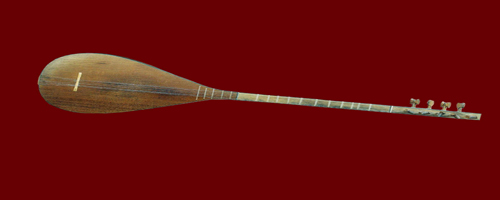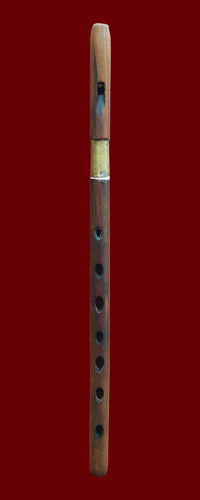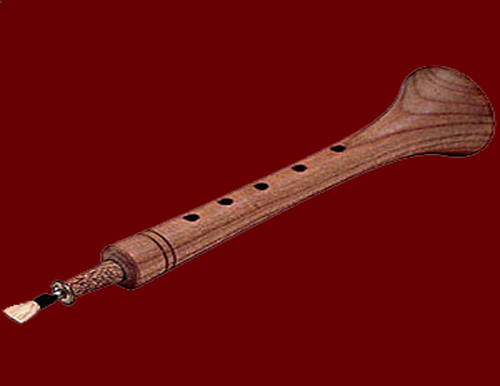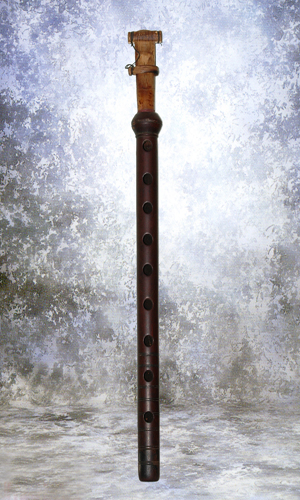National musical instruments
Saz

Saz havası "Misri". Dinlə:
The saz whose grandfather was ozan, and great grand-father was gopuz, improved on the basis of 3, 5, 7, 9, 11 strings.
The key parts of the modern saz consisting of a butt-body-scoop, surface wood, surface-breast wood, arm-wrist, sprout, tuning pegs – ear –spiral peg, bow, butt-stretcher, plunge-belt-lace, head stretch, string hair, veil, foot stretcher, string stretcher, stand –mizrab, shirt-sack, holes opened on the surface of the wood are prepared from an old mulberry tree, but the arm and tuning pegs are prepared from nut tree.
The voice ordering of the modern saz formed on the eight stages is known in the region of Nakhchivan as: the first veil head or divani, the second is mute, the third is jighali tajnis, the fourth is mute, the fifth is king, the sixth is mute, the seventh is keshish oghlu, the eighth is jangi Koroghlu, the ninth is mute, the tenth is the foot king veil.
Ud

"Şur" muğamından bir parça. Dinlə:
Darvish Ali, the popular musician who lived in the XVII century in the Middle Asia and played the musical instrument ud masterly, preferred this instrument and called it “the king of all the musical instruments”. The Middle Age authors who admired the voice of ud compared its four strings with fire, water, air, and land stating that it has irreplaceable, unrepeated voice.
Ud also was played in Azerbaijan since the ancient times and ud played an important role in playing our mughams as the tar did. As ud was popular in Azerbaijan in the time of Nizami Ganjavi, the strange beauty of its voice was glorified repeatedly in his works. Safiaddin Urmavi, the Azerbaijani musician of the XIII century, in his “Kitabi-al-advar” (The book of songs) gave detailed information about the appearance of the ud and about its characteristic features. Abdurrahman Jami, the great scientist of the XV century, who regarded the ud the most honorable musical instrument, stated that it had four strings, and it was also stated that Farabi added the fifth string to it in the X century. The work of “Haft-jam” of Mahammad Fuzuli, the great Azerbaijan thinker, gives detailed information about the opportunities of the ud. Since its appearance “the desperate” ud returned to the lap of mother, cradle of childhood, and today it is played in the musical collectives of Nakhchivan Autonomous Republic and occupies a very honorable place among the other musical instruments.
Tar

"Xaric segah" muğamı. Dinlə:
It is said that the tar for the first time was played in Azerbaijan in the period of art and culture promotion in the Middle Ages. The name of this musical instrument is met in the works of Nizami Ganjavi. Fuzuli, in his work “Haft-jam”, rises the third glass under inspired with the songs of the tar. Mirza Sadig Asad oglu, who was born in Shusha in the middle of the XIX century which is surrounded by mountains, after losing his voice brought innovation to the structure of tar for the first time in the East. His innovation in the tar was received as a great contribution in the musical world, in the Transcaucasia, Middle Asia, and even in other countries. Tar, which before had five strings and was played on the knee, for the first time was played on the breast by Sadigjan. The modernized form of tar also played a great role in developing our mughams. Thus, we can say that the tar is not only the instrument to accompany, but also it is a solo performance musical instrument.
CANON

"Bayatı-şiraz" muğamından bir parça. Dinlə:
">One time the most popular musical instrument canon, a very magnificent musical instrument, was forgotten and became unseen on the musical stage. According to the materials discovered, canon used in the Eastern countries, dated back to thousand years in the history of Azerbaijan. The name of this musical instrument is met in the works “Leyli and Majnun”, “Igbalnama” of Nizami Ganjavi. It also was proved that this musical instrument was widely spread in the XVI century. The total number of strings of the canon is 72 strings which have 80-90cm length and 30-40cm width. A special thimble on the point finger of 2 metal “mizrabs” is used to play the canon. Even today it became the decoration of the concert halls and ensembles.
Kamança

"Şur muğamından bir parça. Dinlə:
The history of this musical instrument with bow and string is very ancient in Azerbaijan. The kamancha with a long arm and stand was a musical instrument with a single string. In the late centuries the number of strings was four. Though less but the name of the kamancha is mentioned in the works of Nizami Ganjavi. Safiaddin Urmavi, the Azerbaijani scientist and great musician who lived in the XIII century, Abdulgadir Maraghi, the great musician and composer of the XIV century, Alishir Navai, the proud of the Uzbek people who lived in the XVI century, Mahammad Fuzuli, the great Azerbaijan poet, mentioned kamancha in their works side by side with other musical instruments. So, one can say that kamancha found its top level of usage in the XVI-XVII centuries and occupied an honorable place of its time among the rest musical instruments.
PIPE

"Çoban bayatı". Dinlə:
The pipe included to the wind musical instruments was created after the musical instrument ney. The pipe before was played by shepherds, later the amateur musicians used it, but then hundreds of professional musicians included it to their repertoire, and soon the audience pleased it with great pleasure. The musical instrument pipe, shifting from simple to complicated version, was prepared from different materials in different periods of history, such as reed-cane, bone, wood, pottery, and metal. As the pipe was prepared by shepherds it gives an opportunity to say that this musical instrument was invented 10-12 thousand years ago by the local people of Azerbaijan who were engaged in cattle breeding. After the first pipe (having no finger holes) was prepared from a simple pipe, people started to make it of bones and animal teeth. In connection with the pottery promotion people prepared the pipe from the burnt clay. In order to play with this musical instrument, to overcome the difficulties appeared, to get different sound amplitudes, the musicians sought new methods and opened holes on it. By means of half covering the holes, professional musicians got chromatic voices. But to get this voice demanded a special training and talent.
The pipe has wide range technical opportunities. It is possible to play diatonic gammas in a rather rapid temper.
Tulum

"Tulumu" rəqs. Dinlə:
In comparison with other wind musical instruments, the tulum, about which there is less information, consists of two parts – skin bag and a wood passing through it and a zourna. The tulum is usually prepared from the tanned leather of short horn animals, and besides the two arms the rest parts are tied for not to give out the air inside it. The bone arranged in the arm part is for blowing air into it and the mouth part is tied. But the musical instrument is placed into another arm. The air filled leather sack arranged under the armprint of the player is pressed little by little and this time the air passing through the tube of the musical instrument is played by means of fingers. The duration of play and sound diapazone are regulated by pressing the leather sack. Usually the tulum is put into the sack of its size.
Compared with other wind musical instruments, playing tulum is hard. The relation between the leather sack and the musical instruments demands a very high ability of the player. In spite of this, tulum has an advantage too. It is possible to play the tulum for a while after filling it with air. Just for this and other advantages, creation of the tulum was important. For the first time shepherds prepared and played this instrument. The musical instrument tulum appeared in the early period of the class society. The tulum was spread in the regions of Garabagh and Gazakh of Azerbaijan and in Shahbuz, Babak, Sharur regions of Nakhchivan Autonomous Republic. The tulum musical instrument is taught to the young players in some children musical schools acting in Nakhchivan Autonomous Republic.
Zurna

"Cəngi" rəqsi. Dinlə:
The age of this musical instrument is at least 3 thousand years. The zurna, considered the wind musical instrument pleased by the Azerbaijani people and is said to be the instrument to their taste, is met in the “Kitabi-Dada-Gorgud” eposes. In the heroic epos “Koroghlu” of the Azerbaijani people, there is information about zurna. The name of zurna – sur musical instrument was also mentioned in the works of Nizami Ganjavi, the Azerbaijan poet of the XII century.
It becomes clear from the ethnographic observations that it is impossible to imagine the traditional weddings of the Azerbaijani people without zurna. Zurna wind musical instrument prepared from different materials in different periods, later mainly was prepared from mulberry, nut, and apricot trees and improved. The national musical instrument zurna of clear and loud voice is also named “gara-zurna” (black zurna) by people. Very likely, the word “gara” (black) has relation with the black color bull or ox horn that before the zourna was prepared from them. Usually on the surface of the zurna, prepared from the quince, pear, nut, and apricot trees, there are 7 holes, but under part one hole. The zurna of 23-3 cm of length is narrow in the above part, but the diameter at the foot part is large in comparison. A billow is placed to the top of the zurna. The billow is fastened a round form bone reel. Sometimes the professional zurna players decorate the surface of their zurna with designs in order to be seen attractive.
Today in Ordubad, Julfa, Sharur, Shahbuz, Babak, Kangarli, Sadarak regions of Nakhchivan Autonomous Republic and the villages and settlements they cover, the zurna is used in their weddings as well as it was in the old period. The most interesting point is that a group of zourna players of 3 persons give pleasure to the people with their attractive melody.
Balaban

Xalq mahnısı "Sarı gəlin". Dinlə:
The wind musical instrument with eight holes on, but one hole on the backside, prepared from a mulberry tree, is named balaban or “Yasti” (Flat) balaban by people. To the edge a flat double reed pipe is placed, but to the middle a kharak is input. By removing the kharak the tune of the instrument is changed. In most cases, the balaban displays the role of the accompanist together with the gara zourna and saz. The wind musical instrument balaban is also played together with drum and goshanaghara without a zurna. The sound of balaban, the wind national musical instrument of the Azerbaijan people, even nowadays is heard in the weddings, in the ensemble of the folk orchestra too.
GAVAL (TAMBOURINE)

"Azərbaycan xalq ritmləri". Dinlə:
The gaval is differed from the rest percussion instruments as drum and round percussion instruments just for its big size. It is also distinguished for its delicacy and the rings fastened inside. It seems that this percussion instrument is the improved form of the drum and circle. The rhythmic melody of gaval rises wave by wave and rejoices the mood of people. It is a fact that gaval mainly is used by singers, and its form is round and looks like a sieve. Usually it is prepared from the oak, apricot, and other trees. One face of the round ring is covered with leather, and metal bells are fastened inside it. As other percussion instruments, while playing the gaval also it is heated a little because of being tight and sounding well.
NAGHARA (THE DRUM)

"Azərbaycan xalq ritmləri". Dinlə:
One of the ancient musical instruments of the Azerbaijani people is naghara. Its name is met in the epos of “Kitabi-Dada-Gorgud” too. In the epos it is shown as “Gumbur-gumbur nagharalar doyuldu, buramasi altun borular chalindi” (The drums were played loudly, the golden pipes were played). Right this fact is enough to certain the date of the drum.
In the works of Nizami Ganjavi, the great Azerbaijani poet of the XII century, the word “naghara” is often used:
The melody of ney (pipe) is felt
The drum claps, rises its sound
According to the investigations, the history of the drum in Azerbaijan dates very old centuries, to the class society period. Naghara firstly was made of pottery covering its rim with leather. About 3 thousand years ago, the profession of fiancé making spread widely. Thus, no doubt that naghara began to develop from that time. Later different sizes of nagharas were prepared from wood. Both sides of the naghara are covered with leather, and the body of the naghara is tied with a special rope, passing zigzag through the metal rings. Usually that rope is pulled tightly to get a loud voice. While playing the naghara, either the rope or belt are held by the arm. In most cases the naghara is played by means of two special sticks. To play it with hands is one of the characteric cases. The curled stick in the right hand is a bit bigger and is held by the wrist, but the straight stick in the left hand is held by the finger with the belt.


